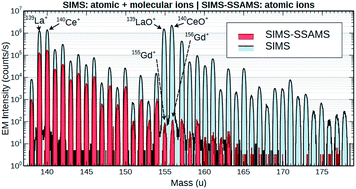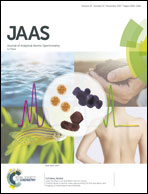Rapid, molecule-free, in situ rare earth element abundances by SIMS-SSAMS†
Abstract
We present a novel method for rapid and high-sensitivity in situ measurements of the rare earth elements (REEs) by combined secondary ion mass spectrometry and single-stage accelerator mass spectrometry (SIMS-SSAMS). Traditional SIMS can be limited in its REE sensitivity by the presence of abundant molecular isobars, whose discrimination is often beyond the range of high mass resolving power, and which require energy filtering and careful calibration to deconvolve. These greatly reduce sensitivity and require a priori assumption of terrestrial isotope ratios for deconvolution, which precludes the analysis of some nuclear forensic materials and presolar stardust grains. With the SSAMS, molecular background is reduced by 5 to 6 orders of magnitude, precluding the need for energy filtering and/or high mass resolution. We demonstrate measurement of Gd isotopes (6 μmol mol−1) in the presence of a molecular background more than 4 orders of magnitude more intense from a single 15 μm spot in a sample of Madagascar hibonite. From the same spot we can resolve 7 nmol mol−1 of Tm from its comparably large background. Traditional SIMS requires the measurement of 47+ masses over 0.5 to 3 hours to perform REE deconvolution, while we collect full REE abundance patterns from several minerals in 10 to 30 minutes per spot. We observe no instrumental mass fractionation (±1%) in either Gd or Dy isotope ratio measurements of NIST610/612 glass. These improvements in sensitivity and measurement rapidity open important new avenues for REE imaging of samples and analyses of particles, nuclear materials, and mineral inclusions.

- This article is part of the themed collection: JAAS Recent HOT articles


 Please wait while we load your content...
Please wait while we load your content...